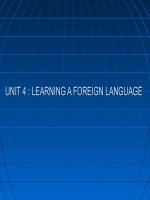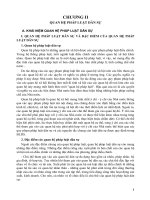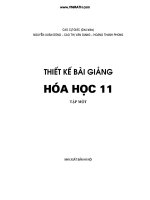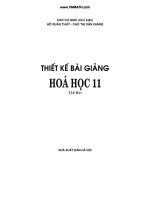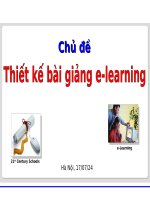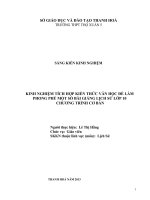thiết kế bài giảng tiếng anh 10 tập hai
Bạn đang xem bản rút gọn của tài liệu. Xem và tải ngay bản đầy đủ của tài liệu tại đây (3.52 MB, 287 trang )
1
NguyÔn Thuû Minh – L−¬ng Quúnh Trang
ThiÕt kÕ bμi gi¶ng
a
TËp HAI
Nhμ xuÊt b¶n Hμ néi
2
Unit 9
Undersea world
Period 1
Reading
I. Objectives
By the end of the lesson, Ss will be able to:
− guess the meaning of words based on contexts and components of
the words
− scan for specific information
− use vocabulary items related to the undersea world to read and talk
about the topic.
II. Materials
Textbook, a map of the world
III. Anticipated problems
Ss may not know much about the marine life and related vocabulary, so T
should be ready to give explanation.
IV. Procedure
Time Steps
Work
arrangement
7'
Warm-up
Competition game
− T sticks the map of the world on the board (the map is
in English).
Group work
3
Time Steps
Work
arrangement
− T asks Ss to work in groups of 5 and gives each group
a set of 5 flash cards with the names of the 5 oceans in
Vietnamese.
− T aks Ss to read the names of the oceans on the map
and match the Vietnamese names with the appropriate
English names. The quickest group will go to the
board and stick the Vietnamese names on the
appropriate places on the map next to the English
names.
− The winner is the group who finds the correct answers
in the shortest period of time.
1. Arctic Ocean: Bắc Băng Dương
2. Antarctic Ocean: Nam Băng Dương (Biển Nam Cực)
3. Pacific Ocean: Thái Bình Dương
4. Atlantic Ocean: Đại Tây Dương
5. Indian Ocean: Ấn Độ Dương
4
Time Steps
Work
arrangement
10'
Before you read
Finding names of sea animals
− T asks Ss to give the Vietnamese names of the
animals in the pictures.
− Then T asks Ss for the English names of these
animals.
− If Ss do not know them in English, T should provide
them.
1. Seal
2. Jellyfish
3. Turtle
4. Shark
Pre-teaching Vocabulary
Note: T should only teach the words which do not
appear in Task 1.
1. Bay (n): Vịnh
2. Mystery (n): a thing of which the cause or origin is
unknown or impossible to explain (bí ẩn)
3. Beneath (prep): under sb/sth (dưới)
4. Submarine (n): tàu ngầm
5. Marine life (n): life in the sea (cuộc sống dưới biển)
6. Fall into (v): to be able to be divided into sth (được
chia thành)
7. Water current (n): dòng nước
8. Organism (n): a living being (sinh vật)
9. At stake: at risk ( bị đe dọa)
− T may ask some Ss to make sentences with the above
words to check their understanding.
Whole class
7'
While you read
Setting the scene
You are going to read a passage on the life in the sea.
While you are reading, do the tasks in the textbook.
Whole
class,
individual
work &
pair work
5
Time Steps
Work
arrangement
Task 1: Gap filling based on word meaning guessing
Instruction: Fill each blank with one of the words in
the box. All of the words appear in the reading passage.
− T writes these words on the board:
Gulf, investigate, oversized, tiny, biodiversity, samples,
challenges, provide
− Then T instructs Ss to read the passage quickly and
stop at the lines that contain these words to guess their
meanings.
− Ss guess the meaning of the words based on the
contexts in the sentences and the components of the
words. For example, to guess the meaning of
oversized Ss can use the relation between small,
oversized and however…or (dù…hay…). T can also
help Ss analyze the formation of the word: oversized=
over (more, higher)+ sized.
− T checks that Ss understand the words correctly.
T can check Ss' understanding by asking them to
provide the Vietnamese equivalents to the words.
− Next, T instructs Ss to use some strategies to do task 1:
+ First, Ss should read through the sentences provided
in the task to identify the part of speech of the word
to fill in each blank. For example, in sentence 1 the
word to fill in should be an adjective, in sentence 2 a
verb, in sentence 3 a noun…
+ Read the first sentence carefully to understand the
meaning roughly. Read the words/phrases in the box
to choose the most suitable one to fill in the blank
+ Continue with the rest of the sentences.
− T asks Ss to work individually to do the task
− T goes around to help Ss when necessary.
− T asks Ss to exchange their answers with other Ss.
6
Time Steps
Work
arrangement
8'
− T asks Ss for their answers and tells them to explain
their choices.
− T gives the correct answers:
1. tiny
2. investigate
3. gulf
4. biodiversity
5. samples
Task 2: Answering questions
Instruction: You are to read the passage again and
answer the questions in the book.
− T instructs Ss to use some strategies to do the task:
+ First, skim the six questions to understand them. As
Ss do this they:
• underline the key words. For instance, in question 1
Ss can underline what percentage, earth's surface,
covered, seas and oceans.
• decide what information they need to find in the text
• look for questions words like "what percentage"
which indicates Ss should read for specific thing like
a number.
+ Go back to the first question and locate the
information for the question by finding the key words
in the passage and mark the place.
+ Read the part carefully to find the answer. Ss can use
their own words.
+ Continue with the rest of the questions.
− T asks Ss to work individually to do the task.
− Then T asks Ss to discuss their answers with their
peers.
− T calls on some Ss to write their answers on the board
and ask them to explain their choices.
7
Time Steps
Work
arrangement
− T feedbacks and gives the correct answers:
1. 75% of the earth's surface
2. By using modern services
3. They investigate the seabed and bring samples of the
marine life back to the surface for further study.
4. We can know a wide range of information, including
water temperature, depth and the undersea
populations.
5. They are those that live on or depend on the bottom
like the starfish, those that move independently of
water currents and those that are carried along by
the currents.
6. The marine life would be at stake if the sea
biodiversity was not maintained.
10'
After you read
Instruction: You are to work in pairs and summarize
the passage by filling each blank with a word or phrase
given in the box.
− T instructs Ss to use some strategies to do the task:
+ Ss read the words and phrases given in the box to
understand the meanings. T can explain the meanings
of some words if Ss find them difficult.
+ Ss read through the summary and identify the part of
speech of the word to fill in each blank.
+ Ss read the passage again for the main ideas and
complete the summary.
− T goes round to offer help.
− T asks Ss to check their summary with a partner
− T checks with whole class
Individual
work, pair
work, and
whole class
8
Time Steps
Work
arrangement
1. three-quarters 5. biodiversity
2. mysterious 6. huge
3. modern 7. plants and animals
4. discoveries 8. closely connected
If there is some time left, Ss can do the extra activity in
groups.
3'
Wrapping up
− T summarises the main points.
− T asks Ss to learn by heart all the new words and
make sentences with them as homework.
Extra activity:
Work in groups to complete the network.
Undersea World
Fish
Mammal
dolphinstarfish
9
Period 2
Speaking
I. Objectives
By the end of the lesson, the Ss will be able to:
− offer solutions to sea problems using should/shouldn't
− talk about causes and consequences of sea problems
− report on discussion results
II. Materials
Textbook, pictures of the sea problems
III. Anticipated problems
Ss may not know some words in this section, so T should be ready to
explain them.
IV. Procedure
Time Steps
Work
arrangement
7'
Warm-up
Picture describing
− T prepares a set of pictures of sea problems
Oil spill
Group
work
10
Time Steps
Work
arrangement
Rubbish on the sea shore
− T asks Ss to work in groups to discuss the questions:
1. What can you see in the picture?
2. What problem is it?
− T asks some Ss to present their answers.
− T gives feedback on Ss' answers.
7'
Task 1: Offering solutions
Instruction: You are required to work in pairs to put the
actions in the order of importance and then say what we
should or should not do.
− Before Ss do the task, T asks them to read through the
actions.
− T elicits or pre-teaches some vocabulary items:
Pair work
11
Time Steps
Work
arrangement
1. Sparingly (adv): not wasting sth (tiết kiệm, không
lãng phí)
2. Dispose of (v): to get rid of sth that one does not want
or cannot keep (bỏ, vứt)
3. Herbicide (n): a substance that is poisonous to
plants, used to destroy plants growing where they are
not wanted (chất diệt cỏ)
4. Pesticide (n): a chemical substance used to kill
insects (thuốc trừ sâu)
5. Release (v): to allow a person or an animal to come
out of a place (thả)
− T reminds Ss that should/shouldn't are used to offer
strong advice or solutions to problems. Emphasize that
should/ shouldn't may imply obligation.
− T asks Ss to work in pairs to put the actions in the
book in the order or importance and say what they
should or should not do. T should encourage Ss to
give the reasons for their choices.
− T goes around to observe Ss working.
− T asks some Ss to present their answers.
− T feedbacks and give correct answers:
a) We should place rubbish and plastic bags in proper
dustbins.
b) We should use water sparingly and do not pollute it.
c) We should not fish for species that are limited,
threatened or endangered.
d) We should dispose of fishing lines and nets properly,
not in or near the water.
e) We should not use herbicides, pesticides and
fertilizers that harm the environment.
f) We should learn all you can about the oceans.
12
Time Steps
Work
arrangement
8'
10'
g) We should keep only the fish that you will eat and
release the rest.
h) We should be smart shoppers and choose our seafood
responsibly.
Task 2: Discussing consequences and offering
solutions
Instruction: Following are some threats to our oceans.
Work in groups to discuss the consequences that might
occur and offer some possible solutions.
− Before Ss do the task, T should ask them to read
through the threats and make sure they understand
them.
− T elicits or introduces some structures Ss can use to
talk about consequences:
1. to make sth/sb + adj (This makes the ocean polluted)
2. to result in + n (Over-fishing results in the extinction
of some fish species)
3. to cause (Oil spills cause ocean pollution)
− T asks Ss to work in groups to discuss the threats,
their consequences and possible solutions. To save
time, T may ask 2 groups to discuss one threat.
− T assigns a group leader for each group to make sure
that group members work cooperatively and take notes
of other members' points.
− T goes round to observe and offer help.
− T takes notes of Ss' mistakes for later correction.
Task 3: Reporting on the discussion results
T calls on some Ss to report that their groups have
discussed and asks other Ss to takes note and compare
with their groups' ideas.
Group
work
Whole
class
13
Time Steps
Work
arrangement
10'
Feedback and correction
− While Ss report, T takes notes of their errors. Then T
gives feedback on Ss' answers.
− T corrects any typical mistakes.
3'
Wrapping up
− T summarises the main points
− T asks Ss to do the extra activity as homework
Extra activity:
You are going to take part in a writing competition in which you have to
produce a paragraph on an ocean threat. The successful writing will be
published in Hoa Hoc Tro magazine.
Write a paragraph of about 150 words to describe the threat and offer
solutions to deal with it.
Period 3
Listening
I. Objectives
By the end of the lesson, the Ss will be able to:
− listen to get specific information about whales
II. Materials
Textbook, cassette
III. Anticipated problems
Ss may not know much about whales, so T should be equipped with some
necessary knowledge of whales.
14
IV. Procedure
Time Steps
Work
arrangement
7'
Warm-up
Vocabulary revision- Guessing game (to revise the
vocabulary related to the sea life)
− T divides Ss into 2 groups : A and B
− T tells Ss the rule of the game: One member from
each group will go and stand in the front of the
class with their backs facing the board. T will write
a word which was learnt from the previous lesson
on the board. Other Ss from each group have to
explain the word without mentioning it or
translating it into Vietnamese so that their
representative can guess the word. The student with
the quickest and correct answer will get 1 point for
their group. Ss take turn to be the representative.
After some turns, the group with more points will
be the winner.
Group work
10'
Before you listen
Discussion
− T asks Ss to work in pairs to discuss the two
questions in the book.
− T calls on some Ss to present their answers.
− T asks other Ss to add more ideas.
Vocabulary pre-teaching
− Before eliciting/pre-teaching some new words, T
helps Ss pronounce the words given in the book. T
may read aloud first and ask Ss to repeat in chorus
and individually.
− T elicits/ teaches some words:
1. Krill (n): nhuyễn thể
2. Whaling: hunting for whales (săn bắt cá voi)
Pair work
and whole
class
15
Time Steps
Work
arrangement
3. Migrate (v): to move from one habitat to another
according to the seasons (di cư)
4. Conservation (n): preservation of the natural
environment and wildlife
10'
While you listen
Task 1: True/False statements
Instruction: You are going to listen to a passage
about whales. Listen and decide whether the
statements provided are True or False. Put a tick (
9
)
in the appropriate box.
− Before Ss listen and do the task, T instructs them to
use some strategies:
+ First, read through the statements to understand
them and underline key words. For example, the
key words in the first statement are: whale, third
largest animal, Earth.
+ Listen to the tape and pay attention to the key words
+ Decide whether the statements are true or false
based on what they can hear.
− T plays the tape once for Ss to do the task.
− T asks for Ss' answers and write them on the board.
− T plays the tape the second time for Ss to check
their answers.
− T asks Ss to work in groups of 4 to compare their
answers.
− T checks Ss' answers by calling on some Ss and
asks Ss to explain their answers.
− If there are a lot of Ss having the same wrong
answer, play that point of the tape for Ss to check
the answer again.
− T gives the correct answers:
1. F (It is the largest)
Individual
work and
group work
16
Time Steps
Work
arrangement
7'
2. T
3. T
4. F (Because of heavy hunting pressure)
5. T
Task 2: Answering questions
Instruction: You are going to listen to the tape again
to answer the questions.
− Before Ss listen and do the task, T instructs them to
use some strategies:
+ Ss read through the questions to understand them
and underline key words. For example, the key
words in the first question are: length, weight, blue
whale.
+ Listen to the tape and pay attention to the key words
+ Write down the answers.
− T asks Ss to guess the answers to the questions
based on the previous times of listening.
− T asks for their guesses and write them on the
board.
− T plays the tape the first time for Ss to check their
guesses.
− T asks Ss to work in pairs to exchange answers.
− T checks Ss' answers.
− T plays the tape again, pausing at difficult points.
− T provides correct answers:
1. The blue whale grows to 30 meters in length and
over 200 tons in weight.
2. Because there is a lot of krill- their favorite food in
cold waters.
3. Cold waters in the North and South Atlantic Ocean
and the North and South Pacific are their favorite
feeding grounds.
4. Heavy hunting is the main reason for the decrease
in whale population.
Individual
work & pair
work
17
Time Steps
Work
arrangement
5. They have asked the International Whaling
Commission to stop most whaling.
6. If we didn't take any measures to protect whales,
they would disappear forever.
Tapescript:
Whales are mammals that live their entire lives in the
water. Some whales are huge. The blue whale, for
example, grows to 30 meters in length and over 200
tons in weight. It is the largest animal that has ever
lived on earth. Whales may also be the most
intelligent animals in the ocean.
Whales like to feed in the cold oceans where there is a
lot of krill- their favorite food. Cold water in the
North and South Atlantic Ocean and the North and
South Pacific are good feeding grounds for whales.
Some whales are known to migrate into warm waters
to bear their calves.
Whale populations decrease quickly due to heavy
hunting pressure. Conservation groups have asked the
International Whaling Commission to stop whaling.
However, Native American hunters, such as the
Eskimo, are still allowed to hunt a limited number of
whales to feed their communities. If no effective
measures were taken to protect whales, these
wonderful animals would disappear forever.
8'
After you listen
− T asks Ss to work in groups to talk about whales,
using the cues provided:
+ their length and weight
+ their feeding grounds and food
+ the reasons for protecting whales
− T goes round to offer help.
Group work
18
Time Steps
Work
arrangement
− T asks some Ss to give a talk about whales.
− T gives feedback and any necessary correction.
3'
Wrapping up
− T summarises the main points
− T asks Ss to learn by heart all new words and do the
extra exercise as homework.
Extra exercise:
Read the passage and decide whether the statements are True or False.
Tick (9) the appropriate box.
Green Turtle, common name for a large sea turtle, is named for the colour
of its fat, although the animal is brownish overall. It is the fastest
swimming turtle, reaching speeds up to 32 km. The green turtle is
common in all warm seas and may sometimes be found, in summertime,
along the North Atlantic coasts of the United States and Europe. Adults
may reach a shell length of more than 1 m and a body weight of more than
180 kg. Like other sea turtles, the green turtle has flipper like forelimbs. It
can be distinguished from other sea turtles in that it has a single pair of
large plates lying on top of the head between the eyes, a relatively smooth
shell lacking any ridges, and only four large, non overlapping plates on
each side of the shell. The male never leaves the sea; the female leaves it
only to lay her eggs. As many as 200 eggs are laid at night in sand above
the reach of the sea.
Statements True False
1. Green turtles can swim more quickly than any turtles.
2. Green turtles live in all seas.
3. The green turtle is different from other turtles in that it has
flipper like forelimbs.
4. The green turtle has eight large plates.
5. Only the female turtle leaves the sea to lay eggs.
Answers: 1. T 2. F 3. F 4. T 5. T
19
Period 4
Writing
I. Objectives
By the end of the lesson, the Ss will be able to:
− write a descriptive paragraph about dolphins by using the facts and
figures from a table
II. Materials
Textbook
III. Anticipated problems
Ss may not be familiar with some words used in the model, so T should
explain them.
IV. Procedure
Time Steps
Work
arrangement
7'
Warm-up
Brainstorming
− T writes the word dolphin on the board.
− T divides the class into 8 groups
− T asks Ss to write down in 3 minutes as many pieces
of information about dolphins as possible.
− After 3 minutes T asks Ss how many details they have
written down. The group with the most details will be
the winner.
− T asks the winner to read aloud the details and other
groups to add more if theirs are different.
− T sets the scene: Today you are going to learn to
write a paragraph about the dolphin, using the
information provided in the table.
Group
work
20
Time Steps
Work
arrangement
12'
Task 1: Exploiting the model
1. Vocabulary pre-teaching
− T elicits or pre-teaches some new words that appear
in the text or in the table:
2. Sperm whale (n): cá nhà táng
3. Squid (n): mực
4. Gestation (n): the process of carrying a young
person or animal inside the mother's body for the
period before birth (thời kỳ thai nghén)
5. Entrapment (n): bị mắc bẫy
6. Habitat (n): the natural environment of an animal or
plant (môi trường sống)
7. Offspring (n): a child, the young of an animal (con)
8. Life span (n): the length of time that that sth is likely
to live (tuổi thọ)
2. Eliciting and introducing some features of a
descriptive paragraph:
− T asks Ss to read through the paragraph in task 1 and
tell what a descriptive paragraph is.
− T checks Ss' definition and give the correct one: A
descriptive paragraph is one in which you write about
what a person, an animal, a thing or a place is like.
− T asks Ss to read the first sentence of the paragraph
and tell Ss that this sentence is the topic sentence in
which the writer provides the name of the animal
he/she is going to write about and its most remarkable
feature. The other sentences describe the animal in
details.
− T asks Ss to look at the table on page 100 and tell
them to compare the order of the features indicated in
the table with the order of the features in the model
paragraph.
Whole
class
and pair
work
21
Time Steps
Work
arrangement
− Tell the Ss that the features in the table follow the
order of the features in the paragraph.
3. Filling the table on page 100 with the information
given in the paragraph
− T asks Ss to work in pairs to complete the table with
the information in the paragraph.
− T asks Ss to exchange their answers with another
pair.
− T checks Ss answers by asking some Ss to go to the
board to write their answers.
− T gives feedback and the correct answers:
SPERM WHALE
Range and habitat All oceans
Prefer waters with high squid
populations
Size Male: 18m in length; 54,000 kg in
weight
Female: 12m in length; 17,000 kg in
weight
Feeding habits Carnivores; eat mainly squid
Eat up to 1,500 kg of food daily
Offspring Give birth to one calf every 5-7
years
Gestation period: 14-19 months
Life span Up to 60-70 years
Special features Biggest animals that have teeth on
Earth
Have the largest brain of all
mammals
Conservation
concerns
At risk due to hunting and accidental
fishing net entrapment
22
Time Steps
Work
arrangement
Task 2: Writing
Instruction: You are going to write a paragraph that
describes the facts and figures of the dolphin provided
in the table.
− First, T asks Ss to write the topic sentence for the
paragraph.
− T checks their topic sentences and provide feedback.
− T asks Ss to write the paragraphs; remind them to
refer to the model paragraph in task 1.
− If Ss find it difficult, T may ask them to write
sentence by sentence and combine them later.
− While Ss write the paragraph, To should go around to
observe and provide help.
Individual
work
12'
Feedback on Ss' writings
− T asks Ss to exchange their paragraph with another
student for peer correction.
− T goes around and collect mistakes and errors.
− T collects some writings for quick feedback.
− T writes Ss' typical errors on the board and elicits
self and peer correction. T provides correction only
when Ss are not able to correct the errors.
− Then T gives general comments on the paragraphs
Pair work
and whole
class
2'
Wrapping up
− T summarises the main points
− For homework, T asks Ss to rewrite the paragraph,
taking into consideration their friends' and T's
suggestions and do the extra activity.
23
Extra exercise
The names of the sea creatures in the box below are hidden in this puzzle.
The words go across, up, down, backward and diagonally. Many letters are
used in more than one word.
When you have founds all the names, please check their Vietnamese
equivalents in the dictionary.
CRAB DOLPHIN JELLYFISH LAMPREY
LOBSTER MOLLUSKS OCTOPUS OTTER
PENGUIN SEA TURTLE SEAL
SHARK SHRIMP SPONGE SQUID
STARFISH STINGRAY WALRUS WHALE
Answer:
24
CRAB cua
DOLPHIN cá heo
JELLYFISH sứa
LAMPREY cá mút đá
LOBSTER tôm hùm
MOLLUSKS động vật thân mềm
OCTOPUS bạch tuộc
OTTER con rái cá
PENGUIN chim cánh cụt
SEA TURTLE rùa biển
SEAL hải cẩu
SHARK cá mập
SHRIMP tôm
SPONGE bọt biển, hải miên
SQUID mực
STARFISH sao biển
WALRUS hải mã, con moóc
WHALE cá voi
Period 5
Language Focus
I. Objectives
By the end of the lesson, the Ss will be able to:
− distinguish the sounds /iə/, / eə/ and /uə/
− pronounce the words and sentences containing these sounds correctly
− use Should and Conditional type 2 appropriately
II. Teaching aids
Textbook, pictures
III. Anticipated problems
Ss may find it difficult to pronounce the words containing the three sounds
/iə/, / eə/ and /uə/, so T should prepare a lot of practice.
IV. Procedure
Time Steps
Work
arrangement
15'
Pronunciation
Pronouncing the three sounds separately:
− T models the three sounds twice or three times.
− T pronounces the sounds and ask Ss to repeat.
Whole
class and
pair work
25
Time Steps
Work
arrangement
− Ss practice pronouncing the sounds individually.
− T gives feedback.
Pronouncing words containing the sounds
− T reads the words in each column all at once.
− T reads the words once again, each time with a word
in each column to help Ss distinguish the differences
between the sounds in the words.
− T reads the words and ask Ss to repeat them.
− T asks Ss to practice pronouncing the words in pairs.
− T goes around to provide help.
− T asks some Ss to pronounce the words.
− T givescorrection if necessary.
Reading the sentences with words containing the
sounds
− T reads the sentences and ask Ss underline the words
with the sounds and write /iə/, / eə/ or /uə/ under
them.
− T asks Ss to practice the sentences in pairs.
− T goes around to provide help.
− T asks some Ss to read the sentences.
− T gives feedback.
15'
Grammar
Should and shouldn't
a. Presentation
− T revises the use of should and shouldn't quickly:
+ In this lesson, should and shouldn't are used to offer
solutions and give strong advice.
You should do sth= it is a good thing to do or the right
thing to do
E.g: You look tired. You should go to bed.
Whole
class,
individual
work and
pair work
